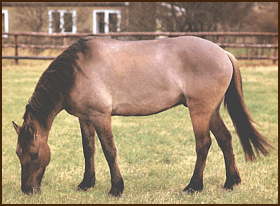
HORSES OF THE WORLD
| CRIOLLO
Origin: |
 Photo supplied by Horse Directory Australia © |
History:
The Criollo originated in Argentina from horses imported by Spanish
Conquistadores in the 16th century. Many of these horses were abandoned or escaped and
formed feral herds. Only the strongest animals survived the extreme climate of intensely
dry summers and severe winters, well adapted, tough and possessing great stamina. The
Criollo soon became popular with the gauchos, the cowboys of the Pampas, who became expert
horsemen. Spanish settlers used the breed for riding and as pack horses in the vast often
inhospitable territory.
Fenced crops and livestock breeding soon reduced the numbers of feral herds. In 1806 the
British introduced the Thoroughbred to Argentina, soon followed by the Percheron brought
in by the French. A cross with the Thoroughbred produced a lighter more elegant horse and
Percheron influence a larger, heavier version suitable for draught work. By the end of the
19th century the Criollo was almost extinct.
To preserve the "creole" horse of Argentina the Sociedad Rural de Argentina was
formed in 1917. A herd of 200 mares was found who helped the breed recover. At first they
became known as Argentine, then as Argentine Criollo and later as Criollo as horses in
Uruguay and Brazil are of the same type and ancestry.
Their extraordinary endurance is demonstrated by the journey of Aime` Felix Tschiffley who
rode from Buenos Aires to Washington D.C. in the USA from 1925 to 1928, a journey
of 10.000 miles through one of the world's most difficult terrain. He took two Criollo
geldings altering their use as mount and pack horse. The horses soundly made the trip and
were shipped back to Argentina where they lived to an old age.
Characteristics:
sturdy, compact
Head: medium sized head; slightly concave profile; wide set
eyes; alert ears
Neck: short, muscular
Body: short, deep body; well sprung ribs, sloped croup
Legs: short, strong limbs; plenty of bone below the knee
Feet: exceptionally sound feet
Mane and Tail: thick; tail is always carried close to
buttocks
Color: mostly dun with dark points, often with dorsal stripes
Height: 13.3 to 15.3hh
Temperament: good
Qualities: tough, sound, tremendous stamina, fast, agile,
adaptable
Today:
The Criollo is popular for pleasure riding and rodeo
events as it is easy to handle, agile and quite fast. It is also used as working cow
horse. Crossed with the Thoroughbred the Criollo makes an excellent horse for polo
competitions.
![]()